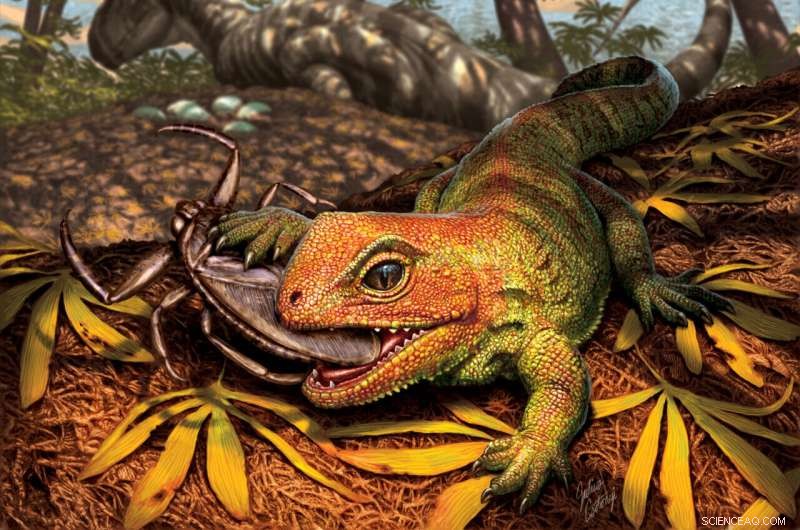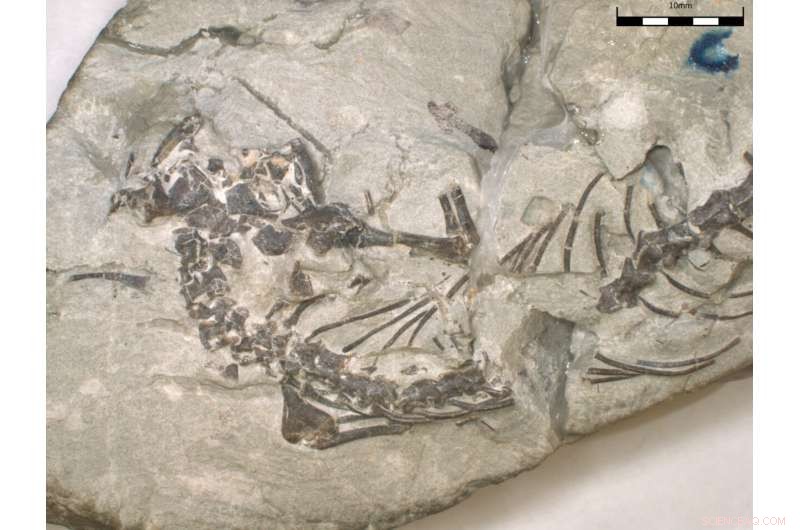
Un'interpretazione artistica di una specie estinta di recente scoperta di rettile simile a una lucertola appartenente allo stesso antico lignaggio del tuatara vivente della Nuova Zelanda. L'Opisthiamimus gregori, appena scoperto, preda un insetto acquatico ormai estinto (Morrisonnepa jurassica), mentre sullo sfondo il dinosauro predatore Allosaurus jimmadseni custodisce il suo nido. La scena è la pianura alluvionale di un fiume nel Wyoming tardo giurassico, circa 150 milioni di anni fa. Credito:Julius Csotonyi per lo Smithsonian Institution
I ricercatori dello Smithsonian hanno scoperto una nuova specie estinta di rettile simile a una lucertola che appartiene allo stesso antico lignaggio del tuatara vivente della Nuova Zelanda. Un team di scienziati, tra cui il curatore di Dinosauria del Museo Nazionale di Storia Naturale Matthew Carrano e il ricercatore associato David DeMar Jr., nonché l'University College London e il Natural History Museum, il socio scientifico londinese Marc Jones, descrivono la nuova specie Opistiamimus gregori, che un tempo abitava nel Giurassico del Nord America circa 150 milioni di anni fa insieme a dinosauri come Stegosaurus e Allosaurus, in un articolo pubblicato oggi nel Journal of Systematic Paleontology . In vita, questo rettile preistorico sarebbe stato di circa 16 centimetri (circa 6 pollici) dal naso alla coda, e si sarebbe inserito rannicchiato nel palmo di una mano umana adulta, e probabilmente sarebbe sopravvissuto con una dieta di insetti e altri invertebrati.
"La cosa importante del tuatara è che rappresenta questa enorme storia evolutiva che siamo abbastanza fortunati da cogliere in quello che è probabilmente il suo atto conclusivo", ha detto Carrano. "Anche se sembra una lucertola relativamente semplice, incarna un'intera epopea evolutiva che risale a oltre 200 milioni di anni."
La scoperta proviene da una manciata di esemplari, tra cui uno scheletro fossile straordinariamente completo e ben conservato, scavato da un sito incentrato su un nido di Allosaurus nella Formazione Morrison nel Wyoming settentrionale. Ulteriori studi sul ritrovamento potrebbero aiutare a rivelare perché l'antico ordine di rettili di questo animale è stato sminuito dall'essere vario e numeroso nel Giurassico al solo tuatara della Nuova Zelanda sopravvissuto oggi.
Il tuatara assomiglia un po' a un'iguana particolarmente robusta, ma il tuatara e il suo parente appena scoperto non sono affatto lucertole. In realtà sono rincocefali, un ordine che si discostava dalle lucertole almeno 230 milioni di anni fa, ha detto Carrano.
Nel loro periodo d'oro giurassico, i rincocefali sono stati trovati in quasi tutto il mondo, erano di dimensioni grandi e piccole e hanno ricoperto ruoli ecologici che vanno dai cacciatori di pesci acquatici agli ingombranti mangiatori di piante. Ma per ragioni che non sono ancora del tutto comprese, i rincocefali sono quasi scomparsi quando lucertole e serpenti sono diventati i rettili più comuni e diversificati in tutto il mondo.
Questo abisso evolutivo tra lucertole e rincocefali aiuta a spiegare le strane caratteristiche del tuatara come i denti fusi con l'osso mascellare, un movimento masticatorio unico che fa scorrere la mascella inferiore avanti e indietro come una lama di sega, una durata di oltre 100 anni e una tolleranza per climi più freddi.
Seguendo la descrizione formale di O. gregori, Carrano ha affermato che il fossile è stato aggiunto alle collezioni del museo dove rimarrà disponibile per studi futuri, forse un giorno aiutando i ricercatori a capire perché la tuatara è tutto ciò che resta dei rincocefali, mentre ora si trovano lucertole in tutto il mondo.

Fossil skeleton of the new lizard-like reptile Opisthiamimus gregori. The fossil was discovered in the Morrison Formation of the Bighorn Basin, north-central Wyoming, and dates to the Late Jurassic Period, approximately 150 million years ago. Researchers named the new species after Smithsonian’s National Museum of Natural History volunteer Joseph Gregor who spent hundreds of hours meticulously scraping and chiseling the bones from a block of stone that first caught museum fossil preparator Pete Kroehler’s eye back in 2010. The fossil has been added to the museum’s collections where it will remain available for future study. Credit:David DeMar for the Smithsonian Institution
"These animals may have disappeared partly because of competition from lizards but perhaps also due to global shifts in climate and changing habitats," Carrano said. "It's fascinating when you have the dominance of one group giving way to another group over evolutionary time, and we still need more evidence to explain exactly what happened, but fossils like this one are how we will put it together."
The researchers named the new species after museum volunteer Joseph Gregor who spent hundreds of hours meticulously scraping and chiseling the bones from a block of stone that first caught museum fossil preparator Pete Kroehler's eye back in 2010.
"Pete is one of those people who has a kind of X-ray vision for this sort of thing," Carrano said. "He noticed two tiny specks of bone on the side of this block and marked it to be brought back with no real idea what was in it. As it turns out, he hit the jackpot."
The fossil is almost entirely complete, with the exception of the tail and parts of the hind legs. Carrano said that such a complete skeleton is rare for small prehistoric creatures like this because their frail bones were often destroyed either before they fossilized or as they emerge from an eroding rock formation in the present day. As a result, rhynchocephalians are mostly known to paleontologists from small fragments of their jaws and teeth.
After Kroehler, Gregor and others had freed as much of the tiny fossil from the rock as was practical given its fragility, the team, led by DeMar, set about scanning the fossil with high-resolution computerized tomography (CT), a method that uses multiple X-ray images from different angles to create a 3D representation of the specimen. The team used three separate CT scanning facilities, including one housed at the National Museum of Natural History, to capture everything they possibly could about the fossil.
Once the fossil's bones had been digitally rendered with accuracy smaller than a millimeter, DeMar set about reassembling the digitized bones of the skull, some of which were crushed, out of place or missing on one side, using software to eventually create a nearly complete 3D reconstruction. The reconstructed 3D skull now provides researchers an unprecedented look at this Jurassic-age reptile's head.
Given Opisthiamimus's diminutive size, tooth shape and rigid skull, it likely ate insects, said DeMar, adding that prey with harder shells such as beetles or water bugs might have also been on the menu. Broadly speaking, the new species looks quite a bit like a miniaturized version of its only surviving relative (tuataras are about five times longer).
"Such a complete specimen has huge potential for making comparisons with fossils collected in the future and for identifying or reclassifying specimens already sitting in a museum drawer somewhere," DeMar said. "With the 3D models we have, at some point we could also do studies that use software to look at this critter's jaw mechanics." + Esplora ulteriormente